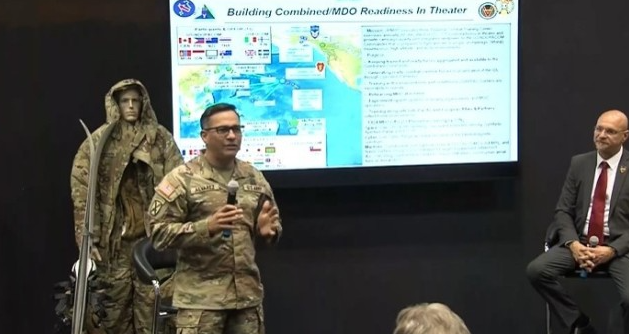Jungle and Arctic training highlighted at AUSA Global Force Symposium
By Lt. Col. Michael Gambone and Mario Hoffmann, TRADOC G2
HUNTSVILLE, Ala. — The U.S. Army Training and Doctrine Command G2 Opposing Forces Directorate and the Joint Pacific Multinational Readiness Center participated in the Association of the United States Army Global Force Symposium Mar. 27.
Presenting at the Warriors Corner during the symposium, the TRADOC G2 OPFOR Directorate and JPMRC informed the Army and defense industry about the various challenges jungle and Arctic operations pose, along with the complexities of replicating the real-world threat in those environments during training to prepare forces for the rapidly evolving multi-domain battlefield. As the Army shifts focus to the Indo-Pacific region and developing large-scale combat operation training scenarios, units must prepare for both operational environments, as each has its own unique set of challenges in which the Army and Joint Force must properly train.
Lt. Gen. Maria Gervais, deputy commanding general, TRADOC, emphasized the importance of realistic training.
“We have to understand how to replicate the operational environment our Soldiers will operate in,” Gervais said. “That doesn’t matter if it is the desert or the Arctic. And we have to understand it from the perspective, what is the equipment we need, how do we replicate the OPFOR, along with understanding the scenarios and how we train.”
Lt. Col. Edgardo Alvarez, deputy commander, JPMRC, discussed the importance of training in the Pacific.
“Gen. Charles A. Flynn, commanding general for U.S. Army Pacific, stated we need JPMRC to become a combat training center,” Alvarez said. “Sending assets overseas, back to the states for training, can take up to 30 days, it’s not realistic. We need to train in the environments we are going to fight in, this is why JPMRC is so important.”
The Warriors Corner panelists discussed the complexities of jungle and arctic conditions, such as extreme temperature fluctuations, rain, snow, and ice.
“We have many unique challenges in the Pacific,” Alvarez said. “From logistics to equipment not working properly in these environments, all of which must be addressed for our units to perform and succeed against our threats.”
Mario Hoffmann, director of the U.S. Army OPFOR Program, TRADOC G2, talked about the challenges of replicating the threat.
“In terms of OPFOR capabilities, we need to decide what is the most important to replicate at the combat training centers and home station training,” Hoffmann said. “We cannot build everything; we try to choose the most capable and likely things we may see in the Pacific.”
Panelists informed attendees about the Decisive Action Training Environment, an unclassified tool used to build exercise scenarios. It consists of operational environment assessments for four regions (Indo-Pacific, Europe, Africa, Caucuses), each with four to six countries in strategic locations as informed by real-world operational conditions and intelligence.
One example of the notional countries in DATE is Olvana with similar military attributes, capabilities, and tactics of the Chinese People Liberation Army, which is the current Indo-Pacific pacing challenge. Hoffmann highlighted senior leader guidance for our Army leaders and Soldiers to understand the PLA threat, as well as the Soviet threat during the Cold War.
To illustrate how the Army has begun transitioning exercises to the Indo-Pacific environment, Hoffmann noted that not only the JPMRC, but also the National Training Center, the Joint Readiness Training Center, and the Mission Command Training Program have already adopted new Indo-Pacific scenarios, as has the U.S. Military Academy at West Point. He also noted that the Combined Arms Center has directed its centers of excellence and schools to shift their military education programs to align with teaching pacing threat capabilities and tactics, along with using the Indo-Pacific Common Scenario Exercise Program.
The presentation concluded with 25th Infantry and 11th Airborne Division Soldiers dressed in environmental operational clothing and gear, discussing their unique experiences in both environments. From equipment issues, Soldier fatigue and replicating the threat in training, the Army must be prepared to overcome the complex challenges of jungle and Arctic operations to succeed on the future multi-domain battlefield


